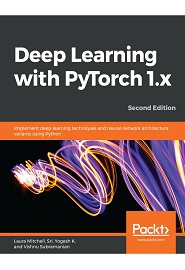
English | 2020 | ISBN: 978-1838553005 | 378 Pages | PDF, EPUB | 347 MB
Build and train neural network models with high speed and flexibility in text, vision, and advanced analytics using PyTorch 1.x
Deep learning powers the most intelligent systems in the world, such as Google Assistant, Siri, and Alexa. Simultaneously, PyTorch is grabbing the attention of deep learning researchers and data science professionals due to its accessibility and efficiency and being more native to the Python way of development.
This book will get you up and running with one of the most cutting-edge deep learning libraries-PyTorch. You’ll learn various fundamental blocks that power modern deep learning and implementing all the new features and offerings of the library. You will also learn how to solve real-world problems using CNN, RNN, and LSTM. You will then get to grips with the concepts of various state-of-the-art modern deep learning architectures, such as ResNet, DenseNet, Inception, and so on, without diving deep into the math behind them. You will see how to build, train and scale a model with PyTorch and dive into complex neural networks such as generative networks and Autoencoders for producing text and images. Furthermore, you will also learn about GPU computing and how they can be used to perform heavy computations. Lastly, you will learn how to work with the Deep Learning based architectures for reinforcement learning problems.
By the end of the book, you’ll be able to implement deep learning applications in PyTorch with ease.
What you will learn
- Build text classification and language modeling systems using neural networks
- Implement transfer learning using advanced CNN architectures
- Learn how to mix multiple models for a powerful ensemble model
- Build image classifier by implementing CNN architectures using PyTorch
- Create a network model to handle sequence data, such as text
- Learn PyTorch 1.x offerings for implementing deep learning algorithms
Resolve the captcha to access the links!